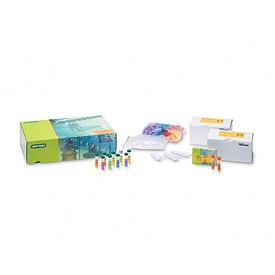
Description
Description
The Crime Scene Investigator PCR Basics Kit is an introductory PCR kit that allows students to simulate DNA profiling as it is commonly used in forensic laboratories. The laboratory activity is designed to introduce the concepts of PCR, which is widely used in forensics, diagnostics, and archaeological procedures. The laboratory is performed without the need for complex genomic DNA extraction steps.
Features and Benefits
- Two–session laboratory activity, 45 min per session
- Provides sufficient materials for eight student workstations, up to four students per workstation
- Includes curriculum with Teacher's Guide, Student Manual, and graphical Quick Guide
With this kit, students are able to:
- Perform real-world DNA profiling
- Use PCR to amplify multiple DNA samples
- Use agarose gel electrophoresis to visualize results
How It Works
DNA profiling determines the exact genotype of a DNA sample, distinguishing one human being from another by identifying each person's unique DNA "bar code." This powerful tool aids investigations of crime scenes, missing persons, mass disasters, immigration disputes, and paternity. Crime scenes often contain tiny biological specimens (blood, semen, hairs, saliva, bones, pieces of skin) from which DNA can be extracted. The reason DNA profiling is so useful for forensic scientists is that a definitive DNA profile can be obtained from a minute biological sample using the power of DNA amplification afforded by polymerase chain reaction (PCR).
There are ~3 billion bases in the human genetic blueprint, and more than 99.5% of them do not vary among human beings. Within the variant areas of the genome are the special polymorphic ("many forms") sequences used in forensic applications. The DNA sequences used for forensic typing are derived from regions of our chromosomes that do not control any known traits and have no known functions. They contain segments of short tandem repeats, called STRs. STRs are very short DNA sequences that are repeated in direct head-to-tail fashion.
The example below shows a locus (known as TH01) actually used in forensic DNA profiling. Its specific DNA sequence contains five repeats of [TCAT]
For the TH01 STR locus, there are many alternate forms (alleles) that differ from each other by the number of [TCAT] repeats present in the sequence. More than 20 different alleles of TH01 have been discovered in people worldwide. Each of us still has only two alleles, one inherited from our mother and one inherited from our father.
Two sample TH01 genotypes
Each STR allele has a different length depending on the number of tandem repeats it contains. When the alleles are amplified by PCR, alleles of different lengths can be distinguished by electrophoresis. The number of tandem repeats contained in each allele can be determined by comparing the locations of the DNA bands with a DNA size standard that corresponds to the known sizes of TH01 alleles. In real crime scene applications, using the international CODIS system, DNA profiling is performed using 20 loci to increase the power of discrimination. With the addition of each locus to the analysis, the possibility that any two genotypes will match due to chance drops off significantly. This exercise allows students to grasp the concept of the power of discrimination — the more loci that are used, the greater the ability to discriminate between any two samples.



